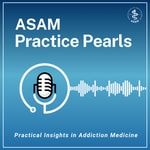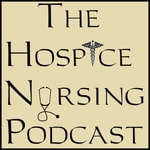ASAM Practice Pearls – Détails, épisodes et analyse
Détails du podcast
Informations techniques et générales issues du flux RSS du podcast.


Classements récents
Dernières positions dans les classements Apple Podcasts et Spotify.
Apple Podcasts
🇨🇦 Canada - medicine
20/06/2025#70🇨🇦 Canada - medicine
07/06/2025#90🇨🇦 Canada - medicine
30/05/2025#73🇨🇦 Canada - medicine
29/05/2025#48🇨🇦 Canada - medicine
28/05/2025#25🇨🇦 Canada - medicine
27/05/2025#25🇨🇦 Canada - medicine
26/05/2025#43🇨🇦 Canada - medicine
25/05/2025#21🇨🇦 Canada - medicine
24/05/2025#19🇨🇦 Canada - medicine
23/05/2025#33
Spotify
Aucun classement récent disponible
Liens partagés entre épisodes et podcasts
Liens présents dans les descriptions d'épisodes et autres podcasts les utilisant également.
See all- https://www.aa.org/
175 partages
- https://smartrecovery.org/
10 partages
- https://www.sicklecelldisease.org/
8 partages
- https://www.facebook.com/addictionmedicine/
17 partages
- https://www.instagram.com/asamorg
17 partages
Qualité et score du flux RSS
Évaluation technique de la qualité et de la structure du flux RSS.
See allScore global : 58%
Historique des publications
Répartition mensuelle des publications d'épisodes au fil des années.
Tackling Tobacco Use Disorder: Challenges, Innovations, and E-Cigarettes
Épisode 3
lundi 17 février 2025 • Durée 24:40
In this episode of ASAM Practice Pearls, Dr. Peter Selby and Dr. Nancy Rigotti explore current and emerging strategies for treating tobacco use disorder (TUD). They discuss the latest pharmacological interventions, behavioral approaches, harm reduction strategies, and the evolving role of e-cigarettes in smoking cessation.
----more----
Have an idea for a future episode? Share it with us at education@asam.org. HostPeter Selby, MBBS, CCFP(AM), FCFP, FASAM
Dr. Peter Selby is a Senior Scientist and Senior Medical Consultant at the Centre for Addiction and Mental Health (CAMH) and Vice-Chair, Research, and Giblon Professor in Family Medicine at the University of Toronto. His research focuses on innovative methods to understand and treat addictive behaviors and their comorbidities. He utilizes technology to scale and test health interventions, with his cohort of over 400,000 treated smokers in Ontario serving as an example. Dr. Selby has received over $100 million in grant funding from CIHR, NIH, and the Ministry of Health and has published more than 200 peer-reviewed articles. His most recent research program utilizes a Learning Health Systems approach to investigate how technology-equitable, collaborative care can enhance the delivery of evidence-based interventions to the patient while providing a more satisfying care experience for patients and providers across systems.
ExpertNancy Rigotti, MD
Dr. Rigotti is a general internist and Professor of Medicine, Harvard Medical School. Her research aims to reduce tobacco-related diseases by improving the range and delivery of tobacco use treatments, especially in health care systems. She founded the Massachusetts General Hospital's Tobacco Research and Treatment Center, which evaluates tobacco treatment interventions in outpatient and inpatient health care settings in the U.S. and beyond (i.e., India, South Africa). Additionally, she evaluates the risks and benefits of electronic cigarettes and has evaluated safety and efficacy of cytisine/cytisinicline, a new pharmacotherapy, with the goal of gaining its approval for use in the U.S.
📖 Show Segments- 00:04 - Introduction
- 00:18 - Case Scenario: Challenges in Treating TUD
- 01:50 - Exploring First-Line and Second-Line Treatments
- 03:17 - Combining Treatments for Better Outcomes
- 05:13 - Motivating Patients and Harm Reduction Strategies
- 08:43 - Controversies and Considerations with E-Cigarettes
- 18:16 - Future Directions in Tobacco Addiction Treatment
- 21:55 - Key Takeaways
- 23:20 - Conclusion and Additional Learning Opportunities
- First-line treatments include varenicline and combination nicotine replacement therapy (NRT), while bupropion and single NRT serve as second-line options. Combining medication with behavioral support improves effectiveness.
- For those unable to quit completely, harm reduction is essential. E-cigarettes, though not risk-free, are less harmful than traditional cigarettes and may assist with smoking cessation. However, their long-term safety remains uncertain, and FDA-approved treatments should be prioritized.
- Educate patients on the risks and benefits of e-cigarettes and favor FDA-authorized options when considering alternatives to smoking.
- Tobacco use disorder should be treated as a chronic disease, with treatment plans tailored to patient preferences and tolerability. Motivational interviewing may enhance adherence and engagement.
- Quitting is a process that often requires multiple attempts. Encourage progress, learn from setbacks, and celebrate small successes.
- New therapies like cytisinicline show promise as effective and potentially safer options for smoking cessation.
- Policy measures such as age restrictions for use, taxation, and marketing controls are critical in reducing smoking and vaping, especially among youth.
- Free behavioral support programs are available and should be actively recommended to patients during office visits.
- ASAM’s State of the Art On-Demand Session: Nicotine
- Cytisinicline for Smoking Cessation: A Randomized Clinical Trial: Rigotti NA, Benowitz NL, Prochaska J, et al., JAMA. 2023;330(2):152-160.
- Electronic Cigarettes for Smoking Cessation - Have We Reached a Tipping Point?: Rigotti NA. N Engl J Med. 2024;390(7):664-665.
- Treatment of Tobacco Smoking: A Review: Rigotti NA, Kruse GR, Livingstone-Banks J, Hartmann-Boyce J. JAMA. 2022;327(6):566-577.
- FDA Authorized E-Cigarettes: FDA Authorized Products
- Web Resource: Smokefree.gov
- Quitline: 1-800-QUIT-NOW
- Text Message Program: SmokefreeTXT
- Youth/Young Adults Text Program: Text DITCHVAPE to 88709
Share your thoughts using #ASAMPracticePearls — we’d love to hear from you!
https://www.linkedin.com/company/american-society-of-addiction-medicine/posts/?feedView=allhttps://www.facebook.com/addictionmedicine/https://x.com/asamorg?mx=2https://www.instagram.com/asamorg/https://www.youtube.com/@asamengagement
Treating Stimulant Use Disorder: Guidelines and Challenges
Épisode 2
lundi 3 février 2025 • Durée 32:14
In this episode of ASAM Practice Pearls, Dr. Stephen Taylor and Dr. Brian Hurley discuss the complexities of stimulant use disorder (StUD). Topics include challenges in managing StUD without FDA-approved medications, the impact of socioeconomic and cultural factors, and practical insights from the ASAM/AAAP guidelines.
----more----
Have an idea for a future episode? Share it with us at education@asam.org. HostStephen M. Taylor, MD, MPH, DFAPA, DFASAM
Dr. Stephen M. Taylor is ASAM’s President-Elect and is board-certified in general psychiatry, child and adolescent psychiatry, addiction psychiatry, and addiction medicine. With over 30 years of practice experience, Dr. Taylor is dedicated to helping adolescents and adults overcome addiction and co-occurring psychiatric disorders. He has served as the Medical Director of the NBA and NBPA Player Assistance and Anti-Drug Program for 16 years and is the Chief Medical Officer of Pathway Healthcare, which operates multiple outpatient addiction and mental health treatment offices across six states.
ExpertBrian Hurley, MD, MBA, FAPA, DFASAM
Dr. Brian Hurley is ASAM’s President and an addiction physician. He is the Medical Director of the Bureau of Substance Abuse Prevention and Control in the Los Angeles County Department of Public Health. He was the co-chair of ASAM and American Academy of Addiction Psychiatry's Clinical Practice Guideline on the Treatment of Stimulant Use Disorder. He has also led numerous grant-funded projects that advance access to medications for addiction treatment across Los Angeles County and is the program lead for LA County’s Substance Abuse Mental Health Services Administration’s Harm Reduction grant award and the Centers for Disease Control Overdose to Action Local grant award.
📖 Show Segments- 00:03 - Introduction
- 00:42 - Personal Experience with StUD
- 03:38 - Overview of ASAM and AAAP Guidelines
- 05:59 - Contingency Management Explained
- 09:03 - Implementing Guidelines in Practice
- 13:50 - Addressing Socioeconomic and Cultural Factors
- 21:46 - Geographic Differences in Stimulant Use
- 23:49 - Future of StUD Treatment
- 29:15 - Key Takeaways
- 31:01 - Conclusion and Additional Learning Opportunities
- Patients with StUD should be assessed and placed in the appropriate level of care using the ASAM Criteria.
- Contingency management is the most effective treatment for StUD and can be delivered alone or in combination with psychosocial approaches like cognitive behavioral therapy, the Matrix Intensive Outpatient Treatment curriculum, or the community reinforcement approach.
- If contingency management is unavailable, explore grants and local resources to implement it effectively.
- While no FDA-approved medications exist for StUD, some have shown clinical effectiveness in helping patients reduce stimulant use.
- Healthcare professionals need to actively work to address health disparities stemming from long-standing community inequities by ensuring their workforce reflects the communities served, understanding systemic barriers, integrating care into communities, and adopting health-focused, non-carceral approaches.
- Treating StUD is not hopeless. Effective treatments exist, and care plans should be tailored to reflect the drug use patterns of the community served.
- When administered under specialized care, controlled substances can be clinically effective in managing StUD.
- Clinical Practice Guideline on the Management of Stimulant Use Disorder, developed by ASAM and AAAP; Access here!
- ASAM’s 56th Annual Pre-conference: Stimulant Use Disorder on Thursday, April 24, 2025; Register here!
- FREE Webinar Series: Management of Stimulant Use Disorder
- ASAM’s 56th Annual Conference session on GLP-1 on Friday, April 25, 2025; Register here!
- Matrix Intensive Outpatient Treatment for People with Stimulant Use Disorders: Counselor's Treatment Manual; Access here!
Share your thoughts using #ASAMPracticePearls — we’d love to hear from you!
https://www.linkedin.com/company/american-society-of-addiction-medicine/posts/?feedView=allhttps://www.facebook.com/addictionmedicine/https://x.com/asamorg?mx=2https://www.instagram.com/asamorg/https://www.youtube.com/@asamengagement
GLP-1 Receptor Agonists Explained: Their Potential Role in Addiction Treatment
Épisode 1
mercredi 22 janvier 2025 • Durée 20:36
In this episode of ASAM Practice Pearls, Dr. Stephen Taylor hosts Dr. Stephanie Weiss from the National Institute on Drug Abuse (NIDA) to explore the potential of GLP-1 receptor agonists (GLP-1RA), particularly semaglutide, in treating alcohol use disorder. They discuss the underlying science, current research, and the challenges and implications of integrating these innovative treatments into addiction care.
----more----
Have an idea for a future episode? Share it with us at education@asam.org. HostStephen M. Taylor, MD, MPH, DFAPA, DFASAM
Dr. Stephen M. Taylor is ASAM’s President-Elect and is board-certified in general psychiatry, child and adolescent psychiatry, addiction psychiatry, and addiction medicine. With over 30 years of practice experience, Dr. Taylor is dedicated to helping adolescents and adults overcome addiction and co-occurring psychiatric disorders. He has served as the Medical Director of the NBA and NBPA Player Assistance and Anti-Drug Program for 16 years and is the Chief Medical Officer of Pathway Healthcare, which operates multiple outpatient addiction and mental health treatment offices across six states.
ExpertStephanie Weiss, MD, PhD
Dr. Stephanie T. Weiss is a Research Physician with the Translational Addiction Medicine Branch (TAMB) of the NIDA Intramural Research Program. She holds a PhD in pharmaceutical chemistry and a medical degree from the Cleveland Clinic Lerner College of Medicine. Board-certified in emergency medicine, addiction medicine, and medical toxicology, Dr. Weiss focuses on caring for patients with poisonings, overdoses, and medication misuse. Her research interests include novel psychoactive substances, medication misuse, and improving urine drug testing interpretation.
📖 Show Segments- 00:03 - Introduction
- 01:19 - Exploring GLP-1RA in the News
- 02:49 - Scientific Background of GLP-1 RA
- 05:38 - Current Research on Semaglutide
- 07:13 - Study Design and Methodology
- 10:38 - Potential Applications of GLP-1RA Beyond Alcohol Use Disorder
- 12:15 - Challenges in Integrating GLP-1RA into Addiction Care
- 15:16 - Practical Steps for Addiction Care Providers
- 18:19 – Looking to the Future
- 19:27 – Conclusion and Additional Learning Opportunities
- Semaglutide, a GLP-1RA, is currently being studied as a potential adjunctive therapy for alcohol use disorder.
- It shows promise for treating various substance use disorders and is generating significant excitement in the addiction medicine field.
- Challenges to utilizing GLP-1RA for addiction care include high costs, limited access, and stigma associated with addiction treatment.
- For patients with co-occurring conditions such as type 2 diabetes or obesity and alcohol use disorder, semaglutide may offer dual therapeutic benefits.
- Future research will shed light on the efficacy and safety of GLP-1RA, but questions remain about long-term effects.
- Despite FDA-approved treatments, alcohol use disorder remains severely undertreated. Providers should prioritize these medications while awaiting more data on semaglutide.
- It is important to exercise caution when integrating new treatments such as GLP-1RA into practice.
- ASAM’s 56th Annual Conference: Register here.
- JAMA Psychiatry article: Repurposing Semaglutide and Liraglutide.
- NPR article: Ozempic shows promise for alcohol and drug addiction.
- NIDA/NIAAA-funded STAR trial: ClinicalTrials.gov.
- Early studies examining GLP-1RAs in rodent models of alcohol consumption:
- Vervet monkey study on liraglutide: Thomsen et al., Psychopharmacology (2019) 236: 603
- Exenatide randomized clinical trial in Denmark: Klausen et al., JCI Insight (2022) 7: e159863
Share your thoughts using #ASAMPracticePearls — we’d love to hear from you!
https://www.linkedin.com/company/american-society-of-addiction-medicine/posts/?feedView=allhttps://www.facebook.com/addictionmedicine/https://x.com/asamorg?mx=2https://www.instagram.com/asamorg/https://www.youtube.com/@asamengagement
Managing In-Hospital Substance Use
Épisode 7
lundi 3 mars 2025 • Durée 30:50
This episode is part of a special series on improving hospital and clinic-based buprenorphine treatment for opioid use disorder.
In this episode of ASAM Practice Pearls, Dr. Carolyn Chan and Dr. Shawn Cohen welcome addiction medicine expert Dr. Marlene Martin. With extensive experience in helping care teams navigate the complexities of in-hospital substance use, Dr. Martin provides insights on how hospital-based providers can effectively address these challenges with confidence and compassion.
----more----
Have an idea for a future episode? Share it with us at education@asam.org . HostCarolyn Chan, MD MHS
Dr. Carolyn Chan is board-certified in both internal and addiction medicine. She completed her IM residency at UH Hospitals Cleveland Medical Center, followed by an addiction medicine and medical education fellowship at Yale. She provides care in both inpatient and outpatient addiction medicine settings. Currently, she is the Program Director of the University of Cincinnati Addiction Medicine Fellowship and is committed to educating all health professionals on how to provide evidence-based care to individuals with substance use disorders.
Co-HostShawn Cohen, MD
Dr. Shawn Cohen is an addiction medicine doctor at Yale New Haven Hospital. He provides care on a hospital-based addiction consult service and is interested in lowering barriers to MOUD, improving the care of patients experiencing alcohol withdrawal, and making the hospital a more person-centered and less stigmatizing place for people who use substances.
ExpertMarlene Martin, MD
Dr. Marlene Martin is an Associate Professor at UCSF and hospitalist at San Francisco General Hospital. She is the founding director of the Addiction Care Team, which provides compassionate, evidence-based care for hospitalized people with substance use disorders. As Director of Addiction Initiatives for the Latinx Center of Excellence, she coleads PEDAL, a Spanish-language addiction training program for community health workers, aiming to improve care for Latine individuals with substance use disorders. Her work focuses on health equity, harm reduction, and innovative care models.
📖 Show Segments- 00:05 – Introduction
- 02:20 – Case Scenario: Managing In-Hospital Substance Use
- 03:26 – Approaching In-Hospital Substance Use
- 07:16 – Best Practices for Hospital Policies
- 12:55 – Handling Substances and Paraphernalia in Hospitals
- 16:15 – Engaging Stakeholders in Policy Development
- 17:59 – Navigating Policy Concerns
- 21:47 – Managing Adverse Outcomes
- 23:35 – Mitigating Patient Discomfort When a Search Occurs
- 26:15 – Engaging Nurses in Substance Use Management
- 28:15 – Revisiting the Case Scenario
- 30:00 – Conclusion and Additional Learning Opportunities
- Prioritize compassionate care. Approach in-hospital substance use with empathy, understanding, and kindness to foster trust and better outcomes for both patients and healthcare workers.
- Avoid punitive measures. Minimize the involvement of security or law enforcement unless there is an imminent safety threat.
- Maintain open communication. Be transparent with patients about hospital policies, concerns, and available support resources.
- Follow evidence-based treatment. Provide medications and interventions aligned with best practices for managing substance use disorders.
- Incorporate harm reduction strategies. Integrate harm reduction principles into hospital care plans to support patient safety and recovery.
- Address root causes. Identify and manage underlying issues such as untreated pain or withdrawal symptoms that may contribute to substance use.
- Engage a multidisciplinary team. Involve nursing staff, regulatory teams, and hospital leadership to develop and implement effective partnerships and policies.
- Continuously review policies. Regularly update hospital guidelines to reflect evolving best practices and improve outcomes for both patients and staff.
- Empower nursing teams. Provide training and resources to help nurses lead addiction care efforts within hospital settings.
- Consider patient agreements. Use collaborative agreements with patients as a proactive step before resorting to stricter measures.
- ASAM’s Advanced Buprenorphine Education Series: Explore here.
- Martin M, Snyder HR, Otway G, Holpit L, Day LW, Seidman D. In-hospital Substance Use Policies: An Opportunity to Advance Equity, Reduce Stigma, and Offer Evidence-based Addiction Care. J Addict Med. 2023;17(1):10-12. doi:10.1097/ADM.0000000000001046.
- Calcaterra SL, Martin M, Bottner R, Englander H, Weinstein Z, Weimer MB, Lambert E, Herzig SJ. Management of opioid use disorder and associated conditions among hospitalized adults: A Consensus Statement from the Society of Hospital Medicine. J Hosp Med. 2022 Sep;17(9):744-756. doi: 10.1002/jhm.12893. Epub 2022 Jul 26; PMID: 35880813; PMCID: PMC9474708. Read more.
Share your thoughts using #ASAMPracticePearls — we’d love to hear from you!
https://www.linkedin.com/company/american-society-of-addiction-medicine/posts/?feedView=all https://www.facebook.com/addictionmedicine/ https://x.com/asamorg?mx=2 https://www.instagram.com/asamorg/ https://www.youtube.com/@asamengagement
Balancing Patient Confidentiality and Legal Obligations
Épisode 6
lundi 3 mars 2025 • Durée 36:44
This episode is part of a special series on improving hospital and clinic-based buprenorphine treatment for opioid use disorder.
In this episode of ASAM Practice Pearls, Dr. Stephen Holt and Dr. Shawn Cohen welcome addiction medicine expert Dr. Catherine Trimbur. They explore the delicate balance between protecting patient confidentiality and fulfilling legal responsibilities when responding to requests from parole officers, child welfare agencies, and other external entities.
----more----
Have an idea for a future episode? Share it with us at education@asam.org . HostStephen Holt, MD, MS, FACP, FASAM
Dr. Stephen Holt has been an attending physician at Yale-New Haven Hospital since 2008 and is an Associate Professor of Medicine at Yale School of Medicine. He is the Director of the Yale Addiction Recovery Clinic and the Associate Program Director for Yale's Primary Care Internal Medicine Residency Program. He is board-certified in Addiction Medicine and Internal Medicine. He has published and lectures frequently on a variety of addiction medicine topics and has won numerous teaching awards at the local, regional, and national levels.
Co-HostShawn Cohen, MD
Dr. Shawn Cohen is an addiction medicine doctor at Yale New Haven Hospital. He provides care on a hospital-based addiction consult service and is interested in lowering barriers to MOUD, improving the care of patients experiencing alcohol withdrawal, and making the hospital a more person-centered and less stigmatizing place for people who use substances.
ExpertCatherine Trimbur, MD, MPH
Dr. Catherine Trimbur, triple board-certified in internal medicine, addiction medicine, and palliative care, is an assistant professor at Brown University’s Warren Alpert Medical School. She leads Brown’s Transitions Clinic, providing comprehensive care for formerly incarcerated individuals with serious illnesses and substance use disorders. Dr. Trimbur also offers pain management and palliative care at the Rhode Island Adult Correctional Institute. Committed to medical education, she has developed a curriculum to help residents enhance empathy and reduce stigma in marginalized patient care. She serves on several university and hospital committees related to primary care and health equity.
📖 Show Segments- 00:03 – Introduction
- 02:15 – Case Scenario: Navigating Parole and Child Welfare Requests
- 03:45 – Differences Between Parole and Probation
- 06:33 – Navigating Parole and Probation in Patient Care
- 09:51 – Advocating for Patients: Effective Communication Strategies
- 13:25 – Advocacy and Education in Interactions with Parole Officers
- 24:09 – Interacting with Child Welfare Systems
- 30:00 – Success Stories and Legislative Impact
- 34:28 – Revisiting the Case Scenario
- 35:56 – Conclusion and Additional Learning Opportunities
- Prioritize patient autonomy. Engage patients in decisions regarding information sharing and advocate for their strengths and progress.
- Educate stakeholders. Help parole officers, judges, and other officials understand the medical and psychosocial aspects of addiction treatment to foster more recovery-focused decisions.
- Clarify legal terminology. Understanding distinctions—such as parole (post‑incarceration supervision) versus probation (prison alternative)—helps providers navigate legal complexities more effectively.
- Advocate through documentation. Writing letters to judges and parole officers highlighting patients' progress and health needs can influence decisions, such as waiving fees or avoiding re‑incarceration.
- Leverage patient‑controlled testing. Offering urine toxicology screens under patient control can reduce stress and promote adherence with legal requirements.
- Foster a supportive approach. Encourage family involvement with a focus on support rather than punishment to achieve better long‑term outcomes.
- Address stigma head‑on. Recognize patients' strengths and build trust to improve healthcare experiences and overall engagement.
- Use strategic communication. Employ clear, empathetic, and informed communication with legal and welfare authorities to achieve the best patient outcomes.
- Be persistent in advocacy. Continuous efforts can drive systemic improvements and enhance support structures for justice‑involved patients.
- Push for policy change. Educate legal personnel and support legislative reforms to create a more supportive system for individuals with substance use disorders.
- ASAM’s Advanced Buprenorphine Education Series: Explore here.
- Docs for Health: Find additional resources for healthcare providers working with justice-involved patients including letter templates.
- Transitions Clinics: The Transitions Clinic Network is building an innovative healthcare model for individuals returning to the community from incarceration.
Share your thoughts using #ASAMPracticePearls — we’d love to hear from you!
https://www.linkedin.com/company/american-society-of-addiction-medicine/posts/?feedView=all https://www.facebook.com/addictionmedicine/ https://x.com/asamorg?mx=2 https://www.instagram.com/asamorg/ https://www.youtube.com/@asamengagement
Creating Realistic Follow-Up Plans for Unstable Patients
Épisode 5
lundi 3 mars 2025 • Durée 28:24
This episode is part of a special series on improving hospital and clinic-based buprenorphine treatment for opioid use disorder.
In this episode of ASAM Practice Pearls, Dr. Shawn Cohen is joined by addiction medicine experts Dr. Carolyn Chan and Dr. Stephen Holt. Together, they explore effective strategies for managing unstable patients and creating realistic follow-up plans that prioritize patient engagement and continuity of care.
----more----
Have an idea for a future episode? Share it with us at education@asam.org . HostShawn Cohen, MD
Dr. Shawn Cohen is an addiction medicine doctor at Yale New Haven Hospital. He provides care on a hospital-based addiction consult service and is interested in lowering barriers to MOUD, improving the care of patients experiencing alcohol withdrawal, and making the hospital a more person-centered and less stigmatizing place for people who use substances.
ExpertsCarolyn Chan, MD MHS
Dr. Carolyn Chan is board-certified in both internal and addiction medicine. She completed her IM residency at UH Hospitals Cleveland Medical Center, followed by an addiction medicine and medical education fellowship at Yale. She provides care in both inpatient and outpatient addiction medicine settings. Currently, she is the Program Director of the University of Cincinnati Addiction Medicine Fellowship and is committed to educating all health professionals on how to provide evidence-based care to individuals with substance use disorders.
Stephen Holt, MD, MS, FACP, FASAM
Dr. Stephen Holt has been an attending physician at Yale-New Haven Hospital since 2008 and is an Associate Professor of Medicine at Yale School of Medicine. He is the Director of the Yale Addiction Recovery Clinic and the Associate Program Director for Yale's Primary Care Internal Medicine Residency Program. He is board-certified in Addiction Medicine and Internal Medicine. He has published and lectures frequently on a variety of addiction medicine topics and has won numerous teaching awards at the local, regional, and national levels.
📖 Show Segments- 00:04 – Introduction
- 00:50 – Case Scenario: Unstable Patient Follow-up
- 02:17 – Building Low-Barrier Clinics
- 06:15 – Building Partnerships with Community Resources
- 09:26 – Troubleshooting Patient Engagement
- 16:11 – Navigating Complex Patient Scenarios
- 19:54 – Strategies for Reengaging Patients in Care
- 23:50 – Reducing Barriers and Integrating Harm-Reduction in Clinics
- 25:25 – Revisit Case Scenario
- 27:20 – Conclusion and Additional Learning Opportunities
- Build strong relationships. Foster connections with patients and providers across inpatient, outpatient, and community settings to ensure seamless transitions.
- Prioritize warm handoffs. Maintain continuity of care through compassionate, consistent communication.
- Stay proactive. Reach out to patients who miss appointments via phone calls or secure messaging to encourage reconnection and demonstrate support.
- Align care with patient goals. Tailor treatment plans to individual needs, acknowledging their personal circumstances and preferences.
- Minimize barriers to care. Offer flexible scheduling, telehealth options, and accommodating policies, such as walk-in availability and relaxed late arrival rules.
- Emphasize harm reduction. Incorporate approaches like long-acting buprenorphine and methadone when appropriate.
- Use monitoring tools thoughtfully. Leverage urine toxicology as a supportive tool rather than a punitive measure.
- Adapt treatment plans as needed. Avoid punitive measures and modify strategies when current approaches are ineffective.
- Engage community resources. Collaborate with local organizations to support patient re-engagement.
- Leverage peer support. Utilize peer recovery coaches or case managers to provide continuous patient support.
- Support prescriber confidence. Offer training and resources to address concerns about managing substance use treatment.
- Develop sustainable follow-up plans. Implement practical, actionable steps to create personalized follow-up plans that meet patient needs.
- Maximize telehealth benefits. Ensure compliance with local and federal regulations while expanding access to care.
- ASAM’s Advanced Buprenorphine Education Series: Explore here.
- American Society of Addiction Medicine. Engagement and Retention of Nonabstinent Patients in Substance Use Treatment: Clinical Consideration for Addiction Treatment Providers. October 2024. Read more.
- Henssler J, Müller M, Carreira H, Bschor T, Heinz A, Baethge C. Controlled drinking–non-abstinent versus abstinent treatment goals in alcohol use disorder: a systematic review, meta‐analysis and meta‐regression. Addiction. 2021 Aug;116(8):1973–1987. doi: 10.1111/add.15329.
- Additional information on SUD privacy 42 CFR part 2: View here.
Share your thoughts using #ASAMPracticePearls — we’d love to hear from you!
https://www.linkedin.com/company/american-society-of-addiction-medicine/posts/?feedView=allhttps://www.facebook.com/addictionmedicine/https://x.com/asamorg?mx=2https://www.instagram.com/asamorg/https://www.youtube.com/@asamengagement
Overcoming Barriers to MOUD at Discharge: Ensuring Continuity of Care from Skilled Nursing Facilities
Épisode 4
lundi 3 mars 2025 • Durée 27:48
This episode is part of a special series on improving hospital and clinic-based buprenorphine treatment for opioid use disorder.
In this episode of ASAM Practice Pearls, Dr. Stephen Holt is joined by addiction medicine experts Dr. Carolyn Chan and Dr. Shawn Cohen. They explore key challenges and solutions in ensuring continuity of care for patients receiving medication for opioid use disorder (MOUD) during discharge from skilled nursing facilities.
----more----
Have an idea for a future episode? Share it with us at education@asam.org. HostStephen Holt, MD, MS, FACP, FASAM
Dr. Stephen Holt has been an attending physician at Yale-New Haven Hospital since 2008 and is an Associate Professor of Medicine at Yale School of Medicine. He is the Director of the Yale Addiction Recovery Clinic and the Associate Program Director for Yale's Primary Care Internal Medicine Residency Program. He is board-certified in Addiction Medicine and Internal Medicine. He has published and lectures frequently on a variety of addiction medicine topics and has won numerous teaching awards at the local, regional, and national levels.
ExpertsCarolyn Chan, MD, MHS
Dr. Carolyn Chan is board-certified in both internal and addiction medicine. She completed her IM residency at UH Hospitals Cleveland Medical Center, followed by an addiction medicine and medical education fellowship at Yale. She provides care in both inpatient and outpatient addiction medicine settings. Currently, she is the Program Director of the University of Cincinnati Addiction Medicine Fellowship and is committed to educating all health professionals on how to provide evidence-based care to individuals with substance use disorders.
Shawn Cohen, MD
Dr. Shawn Cohen is an addiction medicine doctor at Yale New Haven Hospital. He provides care on a hospital-based addiction consult service and is interested in lowering barriers to MOUD, improving the care of patients experiencing alcohol withdrawal, and making the hospital a more person-centered and less stigmatizing place for people who use substances.
📖 Show Segments- 00:03 - Introduction
- 02:35 - Barriers to Continuity of Care
- 07:43 - Navigating Prior Authorizations
- 10:24 - Methadone Discharge Planning
- 14:19 - Extended-release Buprenorphine at Discharge
- 17:44 - Engaging Family and Caregivers
- 19:23 - Staff Education and Advocacy
- 22:14 - Discharge Planning Example Scenarios
- 25:11 - Revisit Case Scenario
- 25:50 - Conclusion and Additional Learning Opportunities
- Build relationships with local stakeholders. Collaborate with nursing facility administrators, intake personnel, and buprenorphine clinics to facilitate smoother transitions for patients.
- Address stigma and education gaps. Work closely with facilities to improve their understanding of MOUD and the importance of comprehensive addiction treatment.
- Be proactive in discharge planning. Arrange follow-up appointments and maintain open communication with all relevant parties to prevent care gaps.
- Anticipate common barriers. Stay ahead of issues like prior authorizations by verifying medication access before discharge.
- Strive for incremental improvements. Small changes can lead to significant advancements in patient care over time.
- Emphasize clear communication. Ensure nursing homes and facilities fully understand discharge plans and patient needs.
- Encourage patient engagement. Motivate patients to involve their support systems in their recovery journey.
- ASAM’s Advanced Buprenorphine Education Series: Explore here.
- Skilled Nursing Facility SUD Toolkit (Massachusetts): Access here.
- Methadone 72-Hour Rule in Hospitals: Read more.
- Methadone 72-Hour Rule in Bridge Clinics: Read more.
- DOJ Guidance: ADA & Opioid Treatment Discrimination: View PDF.
- Legal Action Center Toolkit on Healthcare Discrimination: Access here.
- Grand Rounds on MOUD in Skilled Nursing Facilities: Watch here.
Share your thoughts using #ASAMPracticePearls — we’d love to hear from you!
https://www.linkedin.com/company/american-society-of-addiction-medicine/posts/?feedView=allhttps://www.facebook.com/addictionmedicine/https://x.com/asamorg?mx=2https://www.instagram.com/asamorg/https://www.youtube.com/@asamengagement
Methadone Initiation for Opioid Use Disorder in the Emergency Department
Épisode 14
lundi 19 mai 2025 • Durée 28:03
This episode is part of a special four-part series spotlighting key sessions from ASAM’s 56th Annual Conference.
In this episode of ASAM Practice Pearls, In this episode of ASAM Practice Pearls, Dr. Elizabeth Salisbury-Afshar is joined by Drs. Rachel Haroz, Bill Soares, and Ryan McCormack to discuss their session, Methadone Initiation for Opioid Use Disorder in the Emergency Department. The episode covers implementation strategies, regulatory considerations, and practical steps for introducing methadone as a treatment option in emergency care.
----more----
Have an idea for a future episode? Share it with us at education@asam.org. HostElizabeth Salisbury-Afshar, MD, MPH, FAAFP, FACPM, DFASAM
Dr. Elizabeth Salisbury-Afshar is a family medicine, preventive medicine/public health, and addiction medicine physician. She is an Associate Professor at the University of Wisconsin School of Medicine and Public Health in Madison, Wisconsin. She is a core faculty member for the Addiction Medicine Fellowship at the University of Wisconsin, and her clinical roles include addiction medicine consult service and serving as medical director of a low-barrier walk-in clinic serving people who use substances. She is also the Program Director of the Preventive Medicine Residency at UW-Madison and Medical Director of Harm Reduction Services at the Wisconsin Division of Public Health. Dr. Salisbury-Afshar's work focuses on expanding access to evidence-based addiction treatment and harm reduction services. She has over 14 years of experience practicing in medically underserved settings. Dr. Salisbury-Afshar lectures nationally on addiction medicine topics, including the treatment of opioid use disorder, harm reduction, the intersection of addiction and the criminal legal system, and public health approaches to reduce overdose mortality. Dr. Salisbury-Afshar is actively involved in ASAM, where she currently serves as the Vice Chair of the Medical Education Council, Course Director of the ASAM-All Rise treatment courts courses, a member of the ASAM Conference Planning Committee, and the Chair of Harm Reduction Special Interest Group.
ExpertRachel Haroz, MD, FAACT
Dr. Rachel Haroz is an associate professor in the Department of Emergency Medicine at Cooper Medical School of Rowan University, the division head of toxicology and addiction medicine, and the center head of the Cooper Center for Healing. She is board-certified in Emergency Medicine, Medical Toxicology, and Addiction Medicine, obtaining her BA in Biology from Brandeis University, her MD from Tufts University, and completing a residency in Emergency Medicine and a fellowship in Medical Toxicology. She has spent the last 20 years working in inner city emergency departments, mostly in the Camden area. She helped build and now staffs the Cooper Center for Healing in Camden, New Jersey, an addiction medicine specialty Center dedicated to treating patients with substance use disorders. In 2016, she helped create and implement BupeFirst ED, an initiative to prescribe buprenorphine from the Emergency Department and bridge patients to treatment with various community partners, and in 2019, she helped launch BupeFirst EMS, an innovative program aimed at initiating buprenorphine via paramedics in the field. She is also heavily involved in education as well as various NJ state initiatives to better serve patients struggling with substance use disorders.
ExpertBill E. Soares III, MD, MS
Dr. William (Bill) Soares is the Director of Harm Reduction Services in the Department of Emergency Medicine at Baystate Medical Center in Springfield, MA, and an Assistant Professor of Emergency Medicine at the University of Massachusetts Chan Medical School-Baystate. He is a practicing emergency and addiction medicine physician researcher who has spent the past 10 years focused on expanding medication treatments and harm reduction services for emergency department patients with opioid use disorder. In his role as Director of Harm Reduction Services, Dr. Soares oversees take-home Narcan, harm reduction safer supply distribution, buprenorphine, and methadone induction programs throughout the four emergency departments in the Baystate Health System. Dr. Soares’s research focuses on clinical decision-making in the emergency department. He has completed a NIDA K08 (1K08DA045933-01) project evaluating provider decisions to prescribe discharge opioid medications to patients presenting with an acutely painful condition. He currently has federal grants from NIDA, AHRQ, and SAMHSA focused on expanding medication treatment and harm reduction for people with substance use disorders. Recently, he led efforts to create a comprehensive inpatient addiction consultation service for the three Baystate community hospitals through a state-level opioid settlement fund grant administered through the Massachusetts Bureau of Substance Use and Addiction Services (BSAS).
ExpertRyan McCormack, MD, MS
Dr. Ryan McCormack is an Associate Professor of Emergency Medicine at the NYU Grossman School of Medicine and practices clinically in the Bellevue Hospital Emergency Department (ED). He is an NIH-funded clinical investigator who has led several multicenter trials with a history of funding from the National Institute on Drug Abuse (NIDA) and its Clinical Trials Network (CTN) and the National Institute on Alcohol Abuse and Alcoholism (NIAAA). His research employs mixed quantitative and qualitative methods and implementation science approaches to translate efficacious behavioral treatments (e.g., motivational interviewing, case management) and pharmacotherapy (buprenorphine, methadone, naltrexone) for substance use disorders into ED settings with a particular focus on highly marginalized patient populations.
📖 Show Segments- 00:05 – Introduction
- 01:16 – The Evolution of Addiction Treatment in Emergency Departments
- 04:19 – Implementing Methadone Protocols: Steps and Best Practices
- 09:40 – Building Relationships and Finding Partners
- 14:32 – Navigating Federal and State Regulations
- 20:23 – The Importance of Multiple Treatment Options
- 23:39 – Policy Changes and the Future of Methadone Access
- 27:18 – Conclusion and Additional Learning Opportunities
- Promote Multidisciplinary Support: Engage various stakeholders within the hospital, including clinical champions, nurses, residents, and administrative staff, to support methadone initiation.
- Partner with OTPs: Establish strong relationships with local Opioid Treatment Programs (OTPs) to ensure continuity of care for patients once they leave the emergency department.
- Implement Flexible Protocols: Develop clear, adaptable protocols for methadone initiation that can be tailored to your institution’s specific needs and resources.
- Offer Education and Training: Provide education and training to emergency department staff about methadone, including its benefits, dosing, and risk management.
- Familiarize Yourself with Policy and Regulations: Understand and navigate federal, state, and local regulations related to methadone. For guidance, use resources such as the State Opioid Treatment Authorities (SOTA).
- Support Future Policy Shifts: Advocate for policy initiatives and legislative changes that could make methadone prescribing more flexible and accessible, potentially decentralizing it from tightly regulated OTPs.
- Identify a Clinical Champion: Addiction pathways are organized, multidisciplinary care plans to support clinical guidelines and protocols. Identifying a clinical champion to help implement these addiction pathways is important for improving patient care.
- Consider Methadone for OUD Treatment in the ED: Methadone is a valuable, life-saving option for treating opioid use disorder. Don’t be afraid to use it.
- ASAM’s 56th Annual Conference Session: Methadone Initiation for Opioid Use Disorder in the Emergency Department Register HERE
- Bridge Treatment: A program of the Public Health Institute that bridges emergency care and community health to create an integrated system that improves health and equity.
- Clinical Toolkit - This toolkit provides referral algorithms, dosing strategies, risk stratification, literature/references, a guide to stakeholder recruitment and relationships, and tips of the trade.
- Overview of Opioid Treatment Program Regulations by State – The Pew Charitable Trusts examines OTP regulations regarding access to care and patient experience across all 50 states and the District of Columbia as of June 2021.
- State Opioid Treatment Authorities (SOTA) – SAMHSA provided list of SOTAs by state.
- Clinical Guidelines for Withdrawal Management and Treatment of Drug Dependence in Closed Settings: Geneva: World Health Organization; 2009.
- Emergency Department Utilization of the Methadone "72-Hour Rule" to Bridge or Initiate and Link to Outpatient Treatment: Huo S, Heil J, Salzman MS, et al. Am J Emerg Med. 2025;89:209-215. doi:10.1016/j.ajem.2024.12.059
- Emergency Department-Initiated Buprenorphine/Naloxone Treatment for Opioid Dependence: A Randomized Clinical Trial: D'Onofrio G, O'Connor PG, Pantalon MV, et al. JAMA. 2015;313(16):1636-1644. doi:10.1001/jama.2015.3474
Share your thoughts using #ASAMPracticePearls — we’d love to hear from you!
https://www.linkedin.com/company/american-society-of-addiction-medicine/posts/?feedView=all https://www.facebook.com/addictionmedicine/ https://x.com/asamorg?mx=2 https://www.instagram.com/asamorg/ https://www.youtube.com/@asamengagement
Emerging Illicit Substances: What Clinicians Need to Know
Épisode 13
lundi 12 mai 2025 • Durée 17:23
This episode is part of a special four-part series spotlighting key sessions from ASAM’s 56th Annual Conference.
In this episode of ASAM Practice Pearls, In this episode of ASAM Practice Pearls, Dr. Stephen Taylor is joined by Drs. Jeanmarie Perrone and Alaina Steck to explore key insights from their session, Emerging Illicit Substances: What Clinicians Need to Know. The conversation covers emerging drugs of concern, clinical challenges, and practical strategies for clinicians navigating this rapidly evolving field.
----more----
Have an idea for a future episode? Share it with us at education@asam.org. HostStephen M. Taylor, MD, MPH, DFAPA, DFASAM
Dr. Stephen M. Taylor is ASAM's President and is board-certified in general psychiatry, child and adolescent psychiatry, addiction psychiatry, and addiction medicine. With over 30 years of practice experience, Dr. Taylor is dedicated to helping adolescents and adults overcome addiction and co-occurring psychiatric disorders. He has served as the Medical Director of the NBA and NBPA Player Assistance and Anti-Drug Program for 16 years and is the Chief Medical Officer of Pathway Healthcare, which operates multiple outpatient addiction and mental health treatment offices across six states.
ExpertJeanmarie Perrone, MD
Dr. Jeanmarie Perrone is a Professor in the Department of Emergency Medicine and the founding Director of the Center for Addiction Medicine and Policy at the University of Pennsylvania. Dr. Perrone leads programs for the treatment of Opioid and Alcohol Use Disorders in the emergency department (ED) and a virtual telehealth bridge clinic (CareConnect). Her work has been funded by city health departments and by NIDA, PCORI, CDC, and SAMHSA. She has advocated at the state and national levels and contributed to working groups to enhance low-barrier treatment access for substance use disorders. She has been recognized with awards for leadership, education and mentorship and her initiatives have been featured in the media including National Public Radio, the New York Times and USA Today.
ExpertAlaina Steck, MD
Dr. Alaina R. Steck is an Associate Professor in the Emory Department of Emergency Medicine. She completed her residency training in Emergency Medicine at Boston Medical Center in Boston, MA, and her fellowship in Medical Toxicology at the Emory / Centers for Disease Control and Prevention Combined Fellowship in Medical Toxicology, followed by board certification in Addiction Medicine. She currently serves as the Medical Director of the Grady Medication for Alcohol and Opioid Use Disorder Treatment clinic, the Addiction Medicine Clerkship Director, Assistant Medical Director at the Georgia Poison Center, and Pharmacology Thread Director at the Emory School of Medicine.
📖 Show Segments- 00:05 – Introduction
- 00:59 – An Overview of the Emerging Illicit Substances Session
- 02:08 – What Practitioners Should Know about Emerging Illicit Substances
- 03:36 – Specific Substances of Growing Concern
- 04:35 – Challenges in Clinical Practice
- 05:33 – Surprising Insights and Discussion from the Session
- 06:40 – Resources for Recent Data Trends
- 07:19 – Key Lessons for Practitioners to Implement Now
- 08:56 – Unique Withdrawal Syndromes
- 11:27 – Anecdotal Examples of Rising Illicit Substances
- 14:06 – Communicating with Colleagues
- 16:14 – Conclusion and Additional Learning Opportunities
- Emerging Illicit Substances: The landscape of psychoactive substances is evolving rapidly, with new agents continually appearing on the market.
- The Rise of Medetomidine as an Illicit Drug Adulterant: Medetomidine, a veterinary anesthetic, is an emerging concern as it seeps into the fentanyl drug supply as a replacement for xylazine in some parts of the country.
- New Withdrawal Syndromes: Medetomidine has led to a unique withdrawal syndrome that requires high-dose opioids and other sedative agents for management.
- Importance of Naloxone: Despite the emergence of new substances, fentanyl remains a major driver of opioid fatalities, and naloxone is still effective for these overdoses.
- Communicate with Colleagues: Regional variations can significantly impact the local drug supply, making communication and information sharing between different parts of the country critical to identifying trends and preparing effective responses.
- Utilize Available Resources: Important resources, such as the National Drug Early Warning System and local drug checking services, can inform clinicians about local and national trends.
- ASAM’s 56th Annual Conference Sessions: Emerging Illicit Substances: What Clinicians Need to Know Register HERE
- Opioid Withdrawal and Autonomic Complications Associated with Medetomidine Adulteration: Access Poster HERE
- CAMP Webinar Recording: An Emerging Adulterant in Philadelphia: Medetomidine Withdrawal in People Who Use Fentanyl - Discusses the latest findings on medetomidine.
- CDC SUDORS Dashboard - National Drug Overdose Fatality Data Source.
- CSFRE NPS Discovery - The Center for Forensic Science Research and Education provides drug and forensic toxicology testing results, trend reports, and emerging new substances data.
- Drug Overdose Toxico-Surveillance (DOT) Reporting Program - The Emergency Department Overdose Biosurveillance Project, conducted by the American College of Medical Toxicology in collaboration with CSFRE, assesses the sociodemographic characteristics, clinical information, and contextual data on opioid and/or stimulant overdoses.
- National Drug Early Warning System (NDEWS) - Provides real-time surveillance and research on emerging drug trends in the U.S., offering tools like machine learning analyses, online monitoring, and community-based reporting to inform public health responses.
- National Forensic Laboratory Information System (NFLIS) - A DEA program that collects and analyzes forensic drug chemistry laboratory data, medical examiner and coroner data, and toxicology laboratory data across the U.S., providing data resources, publications, and a public data query system to support drug enforcement and public health initiatives.
- PENN CAMP: Center for Addiction Medicine and Policy – Offers information and resources related to addiction medicine in clinical services, educational programs, community engagement, harm reduction strategies, research initiatives, and policy and advocacy.
- StreetCheck: Community Drug Checking – A community-partnered platform that streamlines the collection, analysis, and reporting of drug samples for harm reduction programs, offering tools such as a web-based app, training resources, and real-time drug trend data to help communities respond to the evolving illicit drug supply.
- Notes from the Field: Suspected Medetomidine Withdrawal Syndrome Among Fentanyl-Exposed Patients — Philadelphia, Pennsylvania, September 2024–January 2025: Huo S, London K, Murphy L, et al. MMWR Morb Mortal Wkly Rep 2025;74:266–268.
Share your thoughts using #ASAMPracticePearls — we’d love to hear from you!
https://www.linkedin.com/company/american-society-of-addiction-medicine/posts/?feedView=all https://www.facebook.com/addictionmedicine/ https://x.com/asamorg?mx=2 https://www.instagram.com/asamorg/ https://www.youtube.com/@asamengagement
How to Transform Hospitals to Better Care for People with Addiction
Épisode 12
lundi 5 mai 2025 • Durée 26:52
This episode is part of a special four-part series spotlighting key sessions from ASAM’s 56th Annual Conference.
In this episode of ASAM Practice Pearls, Dr. Elizabeth Salisbury-Afshar welcomes Dr. Itai Danovitch to explore highlights from his session, Hospitals as a Frontline for Addiction: Lessons from the START Study. They’ll discuss the pivotal role hospitals play in identifying and treating substance use disorders, drawing on insights and outcomes from the START (Substance Use Treatment and Recovery Team) Study.
----more----
Have an idea for a future episode? Share it with us at education@asam.org . HostElizabeth Salisbury-Afshar, MD, MPH, FAAFP, FACPM, DFASAM
Dr. Elizabeth Salisbury-Afshar is a family medicine, preventive medicine/public health, and addiction medicine physician. She is an Associate Professor at the University of Wisconsin School of Medicine and Public Health in Madison, Wisconsin. She is a core faculty member for the Addiction Medicine Fellowship at the University of Wisconsin, and her clinical roles include addiction medicine consult service and serving as medical director of a low-barrier walk-in clinic serving people who use substances. She is also the Program Director of the Preventive Medicine Residency at UW-Madison and Medical Director of Harm Reduction Services at the Wisconsin Division of Public Health. Dr. Salisbury-Afshar's work focuses on expanding access to evidence-based addiction treatment and harm reduction services. She has over 14 years of experience practicing in medically underserved settings. Dr. Salisbury-Afshar lectures nationally on addiction medicine topics, including the treatment of opioid use disorder, harm reduction, the intersection of addiction and the criminal legal system, and public health approaches to reduce overdose mortality. Dr. Salisbury-Afshar is actively involved in ASAM, where she currently serves as the Vice Chair of the Medical Education Council, Course Director of the ASAM-All Rise treatment courts courses, a member of the ASAM Conference Planning Committee, and the Chair of Harm Reduction Special Interest Group.
ExpertItai Danovitch, MD, MBA, DFAPA, DFASAM
Dr. Itai Danovitch is Professor and Chair of the Department of Psychiatry and Behavioral Neurosciences at Cedars-Sinai Medical Center in Los Angeles. He earned his bachelor's degree from UC Berkeley and his medical doctorate from the UCLA School of Medicine. He completed a psychiatry residency at Columbia University, an addiction psychiatry fellowship at Cedars-Sinai Medical Center, and a Master of Business Administration at the UCLA Anderson School of Management. Dr. Danovitch’s clinical practice and research are focused on the treatment of substance use disorders and the integration of medical and mental health services. His current research is funded by the National Center for Advancing Translational Sciences (NCATS), the National Institute on Drug Abuse (NIDA), and the National Institute of Arthritis and Musculoskeletal and Skin Diseases (NIAMS). He is the author of over 100 articles and book chapters and co-editor of two books on substance use disorders. Dr. Danovitch served as a Governor-appointed state Commissioner to the California Mental Health Services Commission. He is a Distinguished Fellow of the American Society of Addiction Medicine, a Distinguished Fellow of the American Psychiatric Association, and past president of the California Society of Addiction Medicine.
📖 Show Segments- 00:05 – Introduction
- 00:52 – Why the START Study
- 02:32 – Study Methodology and Key Findings
- 05:08 – Key Findings
- 06:46 – Impact and Practical Applications
- 12:28 – Challenges in expanding access to Addiction Consultation Services
- 14:35 – Suggestions for Starting Addiction Consultation Services
- 17:23 – Benefits of having Addiction Consultation Services
- 19:03 – Expanding Addiction Consultation Services
- 23:39 – Proactive Approaches and AI Tools
- 25:02 – Final Thoughts
- 26:11 – Conclusion and Additional Learning Opportunities
- START Study: The START study was a randomized trial conducted at three different sites, focusing on initiating medication for opioid use disorder and connecting patients to aftercare.
- Addiction Consultation Services: Addiction consultation services can play an important role in hospitals providing better care for patients with substance use disorders.
- Effective Interventions: The study found that addiction consultation services significantly increased the likelihood of patients starting medication for opioid use disorder and being linked to follow-up care.
- Importance of Care Managers: Care managers play a significant role in the success of patient treatment. Those who followed up with patients for a month after discharge and addressed any issues that arose were most impactful.
- Utilize Available Resources: Initiating addiction consultation services can be effective if you start with available resources and progressively build on them.
- Financial Constraints: Financing remains the biggest challenge for expanding access to addiction consultation services despite their proven effectiveness.
- Engagement and Early Identification: Identifying and engaging patients early in their hospitalization can prevent delays and improve outcomes.
- Interdisciplinary Support: Support from the entire care team, including nurses, social workers, clinical partners, and others, can improve patient care and outcomes.
- Educational Component: Training and educational interventions for hospital staff can help increase the adoption and effectiveness of addiction services.
- Provide Comprehensive Care: Addiction consultation services can help provide comprehensive care in hospitals for patients with substance use disorders, similar to how other chronic health conditions are managed.
- ASAM’s 56th Annual Conference Sessions: Hospitals as a Frontline for Addiction: Lessons from the START Study Register HERE
- Hospital Addiction Consultation Service and Opioid Use Disorder Treatment: The START Randomized Clinical Trial: Ober AJ, Murray-Krezan C, Page K, et al. JAMA Intern Med. doi:10.1001/jamainternmed.2024.8586
- Pilot randomized controlled trial of a hospital-based substance use treatment and recovery team (START) to improve initiation of medication for alcohol or opioid use disorder and linkage to follow-up care: Ober AJ, Osilla KC, Klein DJ, et al. J Subst Use Addict Treat. 2023;150:209063. doi:10.1016/j.josat.2023.209063
- The Substance Use Treatment and Recovery Team (START) study: protocol for a multi-site randomized controlled trial evaluating an intervention to improve initiation of medication and linkage to post-discharge care for hospitalized patients with opioid use disorder: Ober AJ, Murray-Krezan C, Page K, et al. Addict Sci Clin Pract. 2022;17(1):39. Published 2022 Jul 28. doi:10.1186/s13722-022-00320-7
- A Taxonomy of Hospital-Based Addiction Care Models: a Scoping Review and Key Informant Interviews: Englander H, Jones A, Krawczyk N, et al. J Gen Intern Med. 2022;37(11):2821-2833. doi:10.1007/s11606-022-07618-x.
- Clinical implementation of AI-based screening for risk for opioid use disorder in hospitalized adults: Afshar, M., et al. Nature Medicine. 2025. DOI: 10.1038/s41591-025-03603-z
- Contextual barriers and enablers to establishing an addiction-focused consultation team for hospitalized adults with opioid use disorder: Evans SK, Ober AJ, Korn AR, et al. Addict Sci Clin Pract. 2024;19(1):31. doi:10.1186/s13722-024-00461-x
- Post-hospitalization Care Transition Strategies for Patients with Substance Use Disorders: A Narrative Review and Taxonomy: Incze MA, Kelley AT, James H, et al. J Gen Intern Med. 2024;39(5):837-846. doi:10.1007/s11606-024-08670-5
- The addiction consultation service for hospitalized patients with substance use disorder: An integrative review of the evidence: Danovitch I, Korouri S, Kaur H, et al. J Subst Use Addict Treat. 2024;163:209377. doi:10.1016/j.josat.2024.209377
- Bridge Treatment: A program of the Public Health Institute that bridges emergency care and community health to create an integrated system that improves health and equity.
Share your thoughts using #ASAMPracticePearls — we’d love to hear from you!
https://www.linkedin.com/company/american-society-of-addiction-medicine/posts/?feedView=all https://www.facebook.com/addictionmedicine/ https://x.com/asamorg?mx=2 https://www.instagram.com/asamorg/ https://www.youtube.com/@asamengagement









